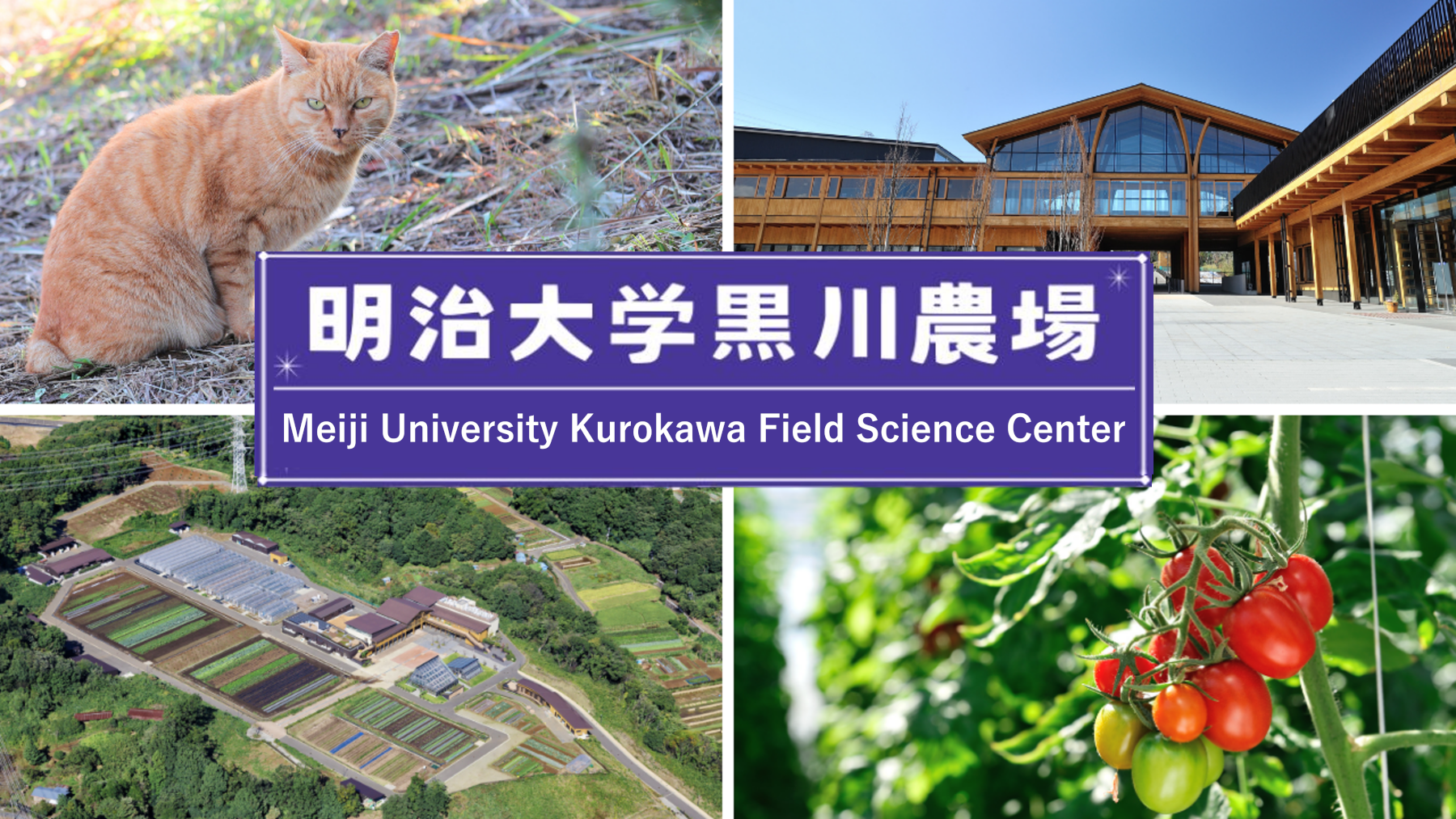
Kurokawa Field Science Center is also an educational facility for the School of Agriculture, Meiji University, and is a base for agricultural research based on the concept of coexistence with the environment, nature, and the surrounding community. It opened in April 2012 with the aim of becoming a multipurpose urban-type university farm through cooperation between the surrounding local community and the university, and carries out unique research distinctive to this field. We will report on diverse research being carried out at Kurokawa Field Science Center, such as that on the establishment of cultivation techniques useful for urban agriculture and the cultivation of endangered plants, along with the attractions of this facility.
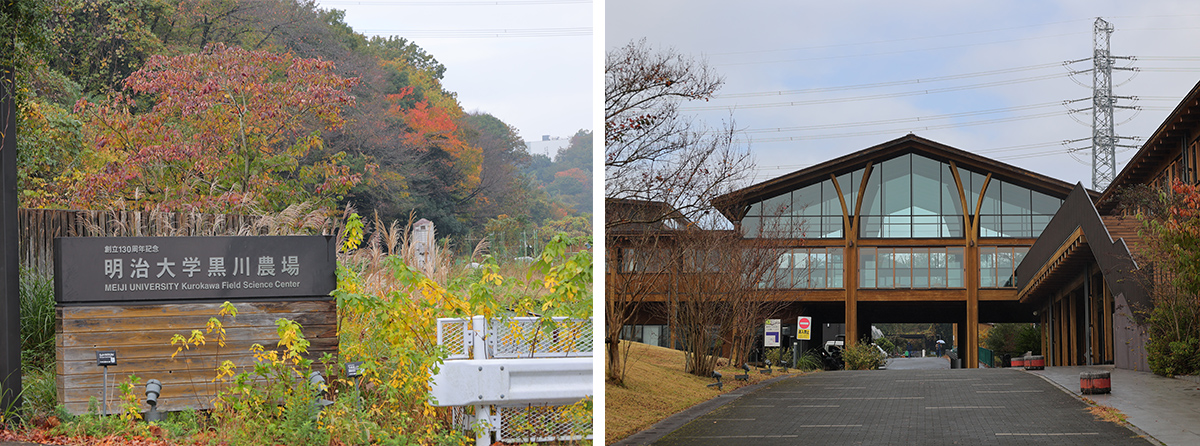
Deepening understanding of agricultural science through hands-on agricultural training on a Large Field
Kurokawa Field Science Center has a total site of about 13.4 hectares. While blessed with a rich natural environment, with woodland (satoyama) occupying approximately half of the area, it takes advantage of its proximity to urban areas to develop unique practical training based on experience and practice.
In the School of Agriculture, Meiji University, all departments experience hands-on agricultural training in the first year so that students can deepen their understanding and advance their research through practical experience. Based on each department’s own curriculum, under the guidance of instructors in charge and university farm staff, students learn crop cultivation management throughout the year, from sowing to harvesting.
The Large Field is mainly used for university farm training. Here, 20 to 30 kinds of crops are grown. Fruit vegetables such as tomatoes, eggplants, and green peppers are the main crops from spring to summer. In fall, the main crops shift to leaf vegetables and root vegetables.

“Another important role of Kurokawa Field Science Center is to establish optimal cultivation techniques for urban agriculture,” says KAWAGISHI Koji, a professor who conducts research using the Large Field and other conventionally cultivated fields. Urban agriculture refers to agriculture conducted in urban areas with large populations.
In the Kanto region, there are large agricultural areas in Ibaraki and Chiba, where there is a certain number of full-time farmers who earn more than 50% of their income from farming. In Kanagawa and Tokyo, however, mainly part-time farmers engage in urban farming, and agricultural succession is in doubt. On the other hand, in urban agriculture, where products are often sold at roadside stations or direct sales shops rather than wholesale to agricultural cooperatives, Professor KAWAGISHI sees a possibility of “advantage because farmers can see customers and explain directly about their products,” and is pursuing his own research.
Research introduction vol. 1
Winter-sweetened spinach (kanjime spinach) with high sugar content as a new specialty for urban agriculture
Kanjime spinach requires a sugar content of 8 degrees or higher in order to be called so, and to cultivate it, the soil temperature must be below 5 degrees Celsius for five days before harvest. The reason the sugar content increases is to prevent the plant itself from freezing in the cold. Kanjime spinach is usually grown in greenhouses in the colder regions of Tohoku and Hokkaido, but this method does not suit the southern Kanto region that is relatively warm. For this reason, the method to cultivate the spinach under a plastic tunnel set on an open field and remove the tunnel before harvesting in winter, is being tried. Varieties suitable for this purpose are also being searched for.
When you think of kanjime spinach, you probably think of a savoy spinach variety with crinkled leaves. However, as a result of cultivation research, it has been found that even if the general spinach variety is cultivated keeping the ground temperature around 6 degree Celsius before harvesting, the sugar content can exceed 8 degrees. It is difficult to consistently exceed 8 degrees, but even if less than that, the sugar content can be expected to be higher than average. So, it is possible to sell sweet and delicious spinach over the counter instead of selling kanjime spinach.
From January to February, when they can be harvested, there are few urban agricultural products that can be sold. We believe that if we establish a method that can be applied to home gardens without using greenhouses, the possibilities for urban agriculture will expand.
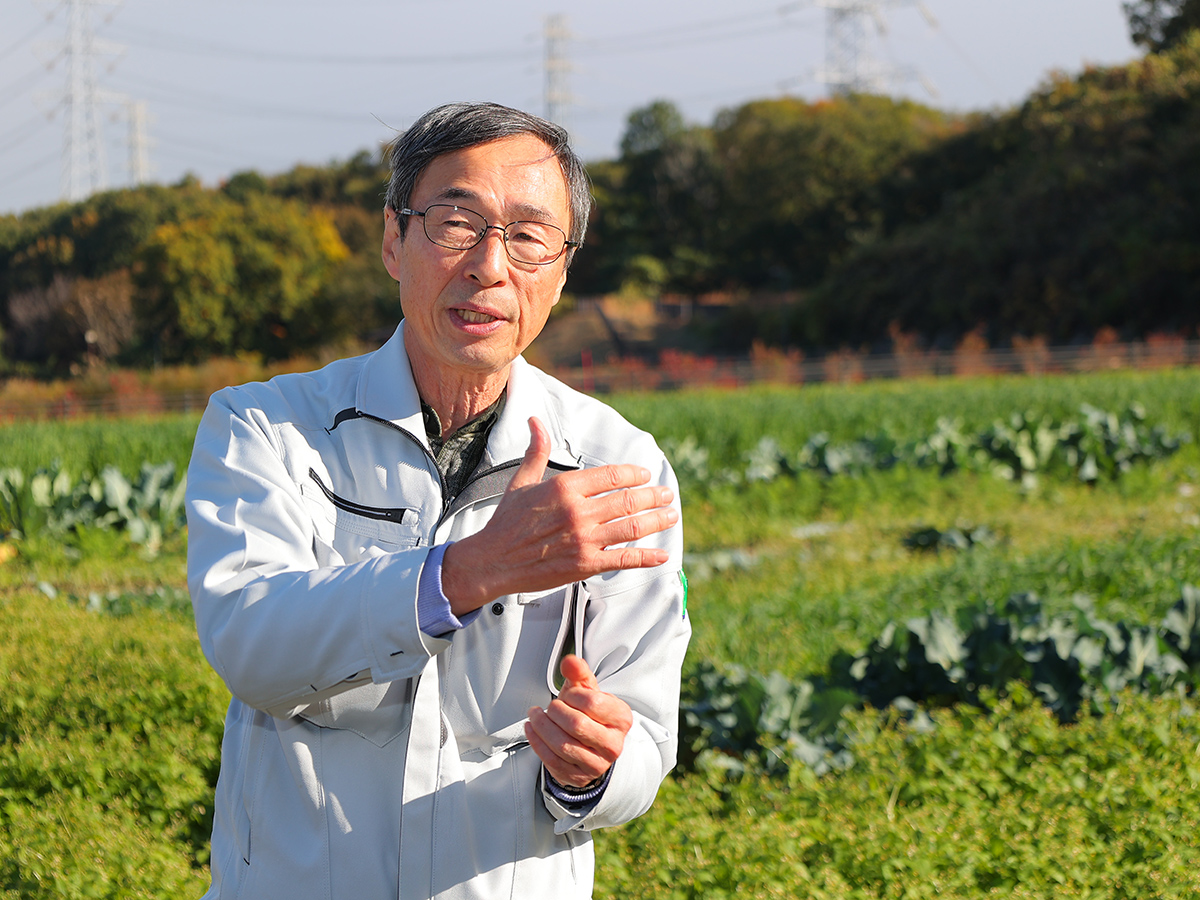
Professor KAWAGISHI Koji
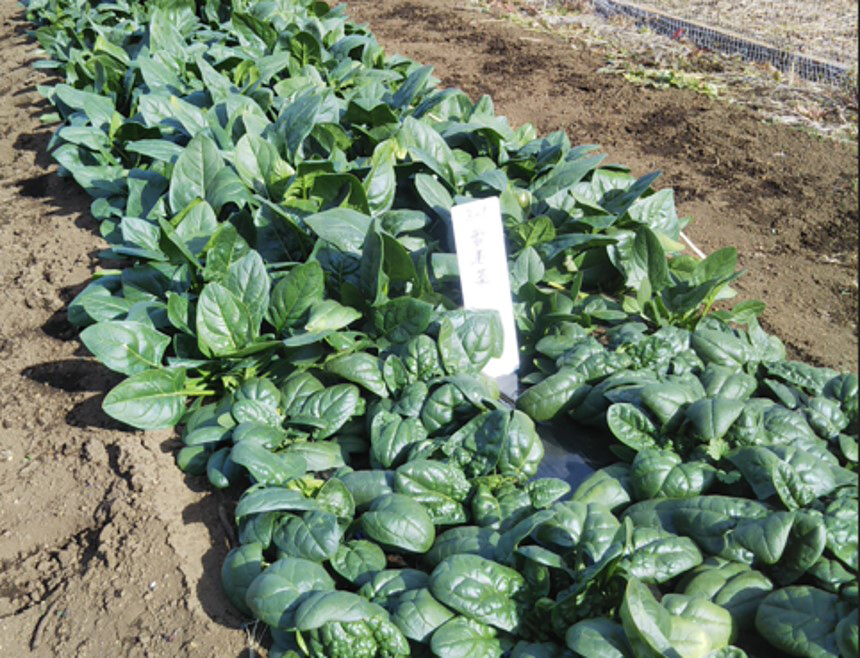
A cultivation area for kanjime spinach in a corner of the conventional cultivation fields. Yukimina02, a savoy spinach variety, is at the front, and Kuronosu, a general variety, is at the back
Commercializing vegetables by raising seedlings using artificial light and hydroponically growing them using sunlight
The Medium Field adjacent to the Large Field mainly produces crops for sale. At the time of the interview, green onions were being harvested, and vegetables such as garlic and Chinese scallions were being grown over the winter. Blueberries are grown between the Large Field and Medium Field. Practical training on making jam is also conducted in the building for food processing practices. The center also aims to produce Meiji University brand processed foods, such as original shochu liquor made from sweet potatoes cultivated and harvested in the center.
▶︎ Kurokawa Nojo (Kurokawa Field Science Center): Meiji University’s original sweet potato shochu
In the greenhouse, tomatoes, strawberries, leaf vegetables and others are hydroponically cultivated and sold. Students are particularly involved in the hydroponic cultivation of spinach. Since the optimum temperature for growing spinach is 20 to 25 degrees Celsius, it cannot be grown in summer. However, a plant factory system that can control the environment will grow seedlings with artificial light and produce spinach as many as 20 times a year based on the calculation.
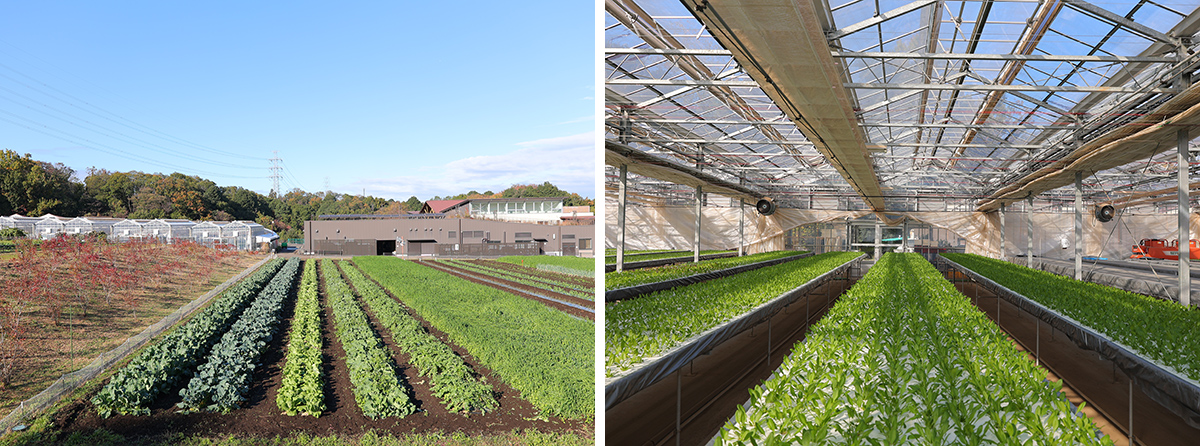
According to IWASAKI Yasunaga, a professor in charge of the Agri Science Laboratory, “It is a great advantage for students to understand how crops grow at their early stage.” They are conducting experimental research that can only be done on university farms, based on making full use of the five senses and taking time and effort to grow crops. “By facing crops not as experimental materials but as crops, plants, and living things, I hope students will hone their sensibilities and senses as well as scientific and logical thinking skills and go out into society with their thoughts,” Prof. IWASAKI says. He says that importance is put on applying and demonstrating research themes upheld through a series of student experiences at Kurokawa Field Science Center and connecting the outcomes with actual production sites.
Research introduction vol. 2
Finding cultivation methods for more efficient growth and returning to the actual production sites
Photosynthesis is important for all crops. In order to grow crops more efficiently, I am researching how to increase the rate of photosynthesis and translocate photosynthates (sugars) to the necessary parts.
If photosynthates are used for growth of leaves and stems, the leaf area will expand and photosynthesis will be promoted, while enlargement of fruits will be suppressed. On the other hand, if photosynthates are used only for fruit enlargement, leaves and stems will not grow and photosynthetic capacity will be insufficient. Nutrients and temperature are directly linked to the rate of photosynthesis and the distribution of photosynthates. A low nutrient level will decrease the number of leaves and the rate of photosynthesis. An excessive nutrient level will overgrow leaves and suppress the fruit growth. As temperatures rise, crops grow faster and need more photosynthates. If the supply of photosynthates cannot keep up, normal growth cannot be achieved. The amount of fertilizer applied must be adjusted according to the temperature and the amount of photosynthesis. Reducing the amount of fertilizer applied is a necessary challenge for Japan, which relies mostly on imported fertilizers.
The sugar concentration in a plant body is the balance after subtracting the amount used for growth and fruit enlargement from the amount of photosynthates. There is no direct measurement method for sugar concentration in a plant body although it is strongly related to the differentiation of flower buds, quality and damage of fruits, and disease resistance level. For this reason, I am developing technology that estimates the sugar concentration in a plant body using a simulation model based on the quantified data of the crop conditions along with weather data to provide optimal fertilizer levels and temperature management.
With the goal of “nurturing people who can create one from zero,” my laboratory is working on a variety of research issues and activities, including breeding (strawberries, sweet potatoes, lupin beans) and processing (fermented foods and wine making), organic cultivation, maintaining biodiversity, material recycling and greenhouse gas reduction, collecting growth information using drones and smart glasses, promoting urban agriculture through DX, and providing help to manage the student farm organization.
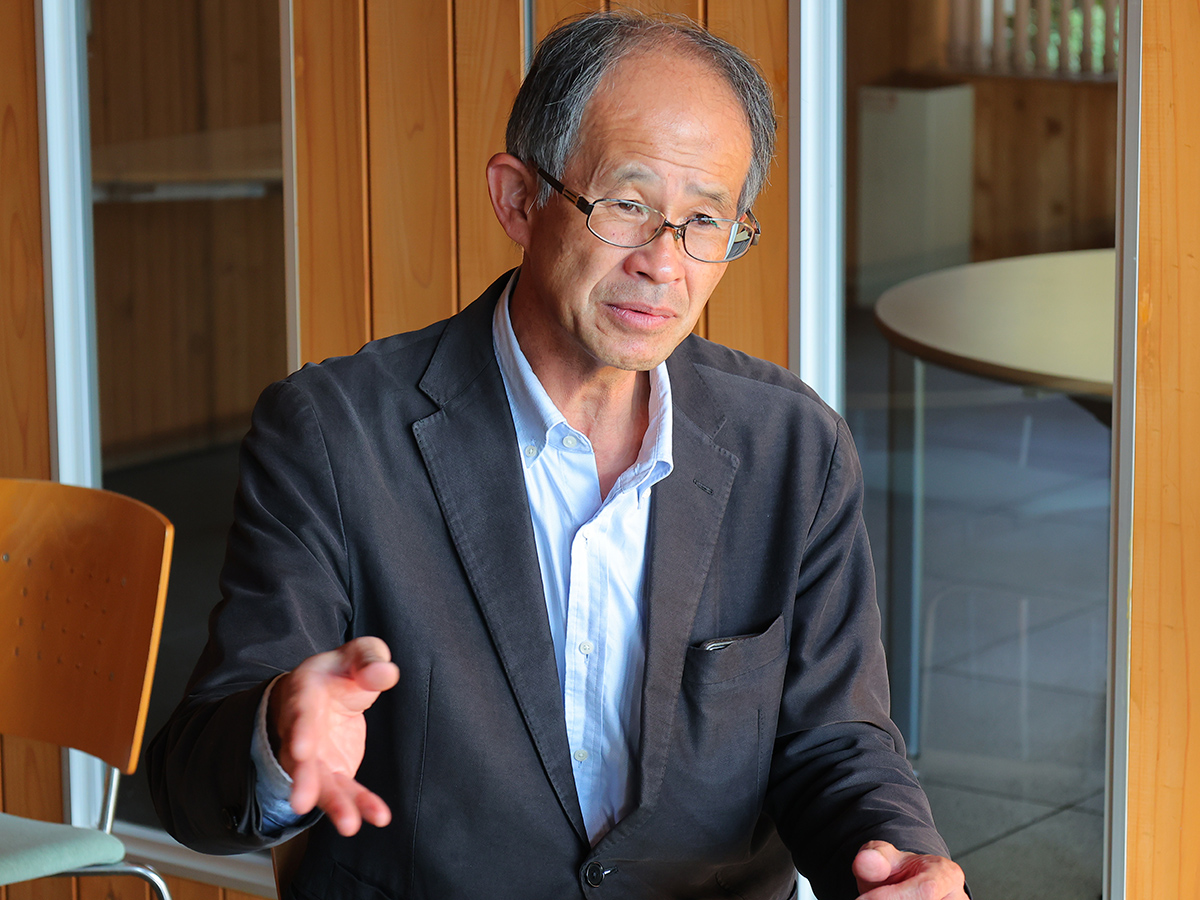
Professor IWASAKI Yasunaga

Automatic measurement of the number of strawberry flowers and fruits by maturity using smart glasses
Exploring the future of urban agriculture through research on rare plants cultivation
The greenhouses, where environmental conditions can be set up individually, are used not only for the students’ research but also for teachers’ research. ITO Yoshikazu, a Senior Assistant Professor at the Advanced Field Agriculture Laboratory, is conducting research on the cultivation of two species of plants designated as threatened species on the Red List of the Ministry of the Environment, Japan.
One is Salicornia europaea, which has a few native habitats in parts of Hokkaido and Okayama. In Europe and other overseas countries, it is used as an edible vegetable called ‘‘sea asparagus’’. KOSHIDA Kaoruko, a second-year master’s student and a member of the laboratory, started her research proposing that the plant be used as a vegetable in Japan too.
The other is Lithospermum erythrorhizon, which is rarely seen in the wild anymore in Japan. It is listed as Threatened IB on the Red List of the Ministry of the Environment, Japan. The roots contain shikonin, and shikonin-derivative, a red-purple pigment, and the dried roots of the plant are called “shikon”. In Japan, it has been used for purple color dyeing called “shikon-zome” since ancient times, and also used as a crude drug. By the way, the school color of Meiji University is bluish-purple, and it is related to kokimurasaki (deep purple) produced by this purple color dyeing. Today, nearly 100% of domestic demand for “shikon” imported from China. The plant is susceptible to disease and sensitive to environmental conditions such as temperature and moisture. Therefore, cultivation experiments are being conducted under various conditions using not only greenhouses but also artificial light plants that can control environmental conditions such as temperature and light intensity with high precision.
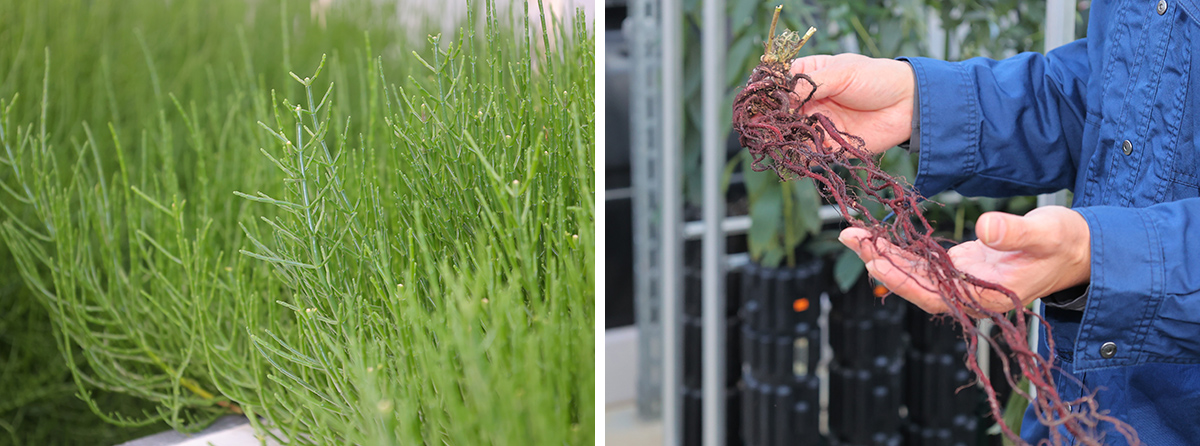
“Stable production of valuable and rare plants could open up new opportunities for urban farming,” says ITO. Research is being conducted into the possibility that the both Salicornia europaea and Lithospermum erythrorhizon will eventually be made into specialty products of Kurokawa Field Science Center.
Research introduction vol. 3
Securing a stable supply of Salicornia europaea, which is edible, and Lithospermum erythrorhizon, which is in high demand
Salt is harmful to many plants, but Salicornia europaea has a very unique property of growing on tidal flats and former salt farm sites and accumulating salt. As the seeds were not available, KOSHIDA grew them from cuttings of sea asparagus (Salicornia europaea’s name as vegetable) which she found in Costco as an imported vegetable. This was the first time in the world that cutting propagation of the plant had been reported, so the paper was published in a British horticultural journal and caused a great sensation. In addition, while it is grown in upland fields overseas, Kurokawa Field Science Center grows it hydroponically and it grows well. The plant is highly nutritious, salty, and delicious when eaten raw. We would like to find ways to cultivate it so that it tastes better without losing yield, and we expect to sell it eventually.
Lithospermum erythrorhizon, on the other hand, was discovered by chance in the mountains of Hinohara-mura in Tokyo about 70 years ago, and has been carefully cultivated by local people. After receiving some of the seeds from them, we have been cultivating the plant. We are seeking a way to grow high-quality Lithospermum roots with darker color and greater dry weight. Efforts are also being made to conduct cultivation research on the plants called camellia and sawafutagi because they contain a large amount of aluminum which helps to fix the color on the cloth as mordant in the process of purple color dyeing using Lithospermum roots.
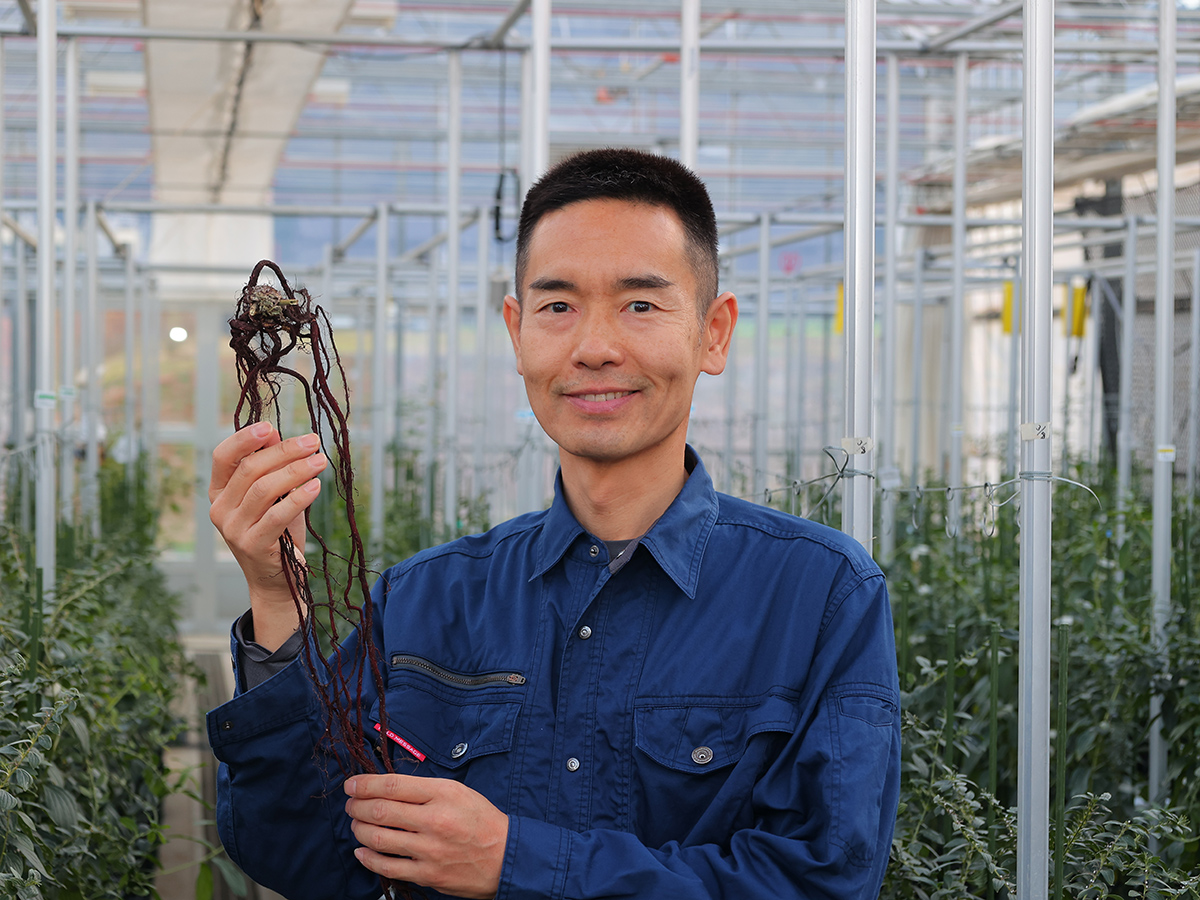
Senior Assistant Professor ITO Yoshikazu
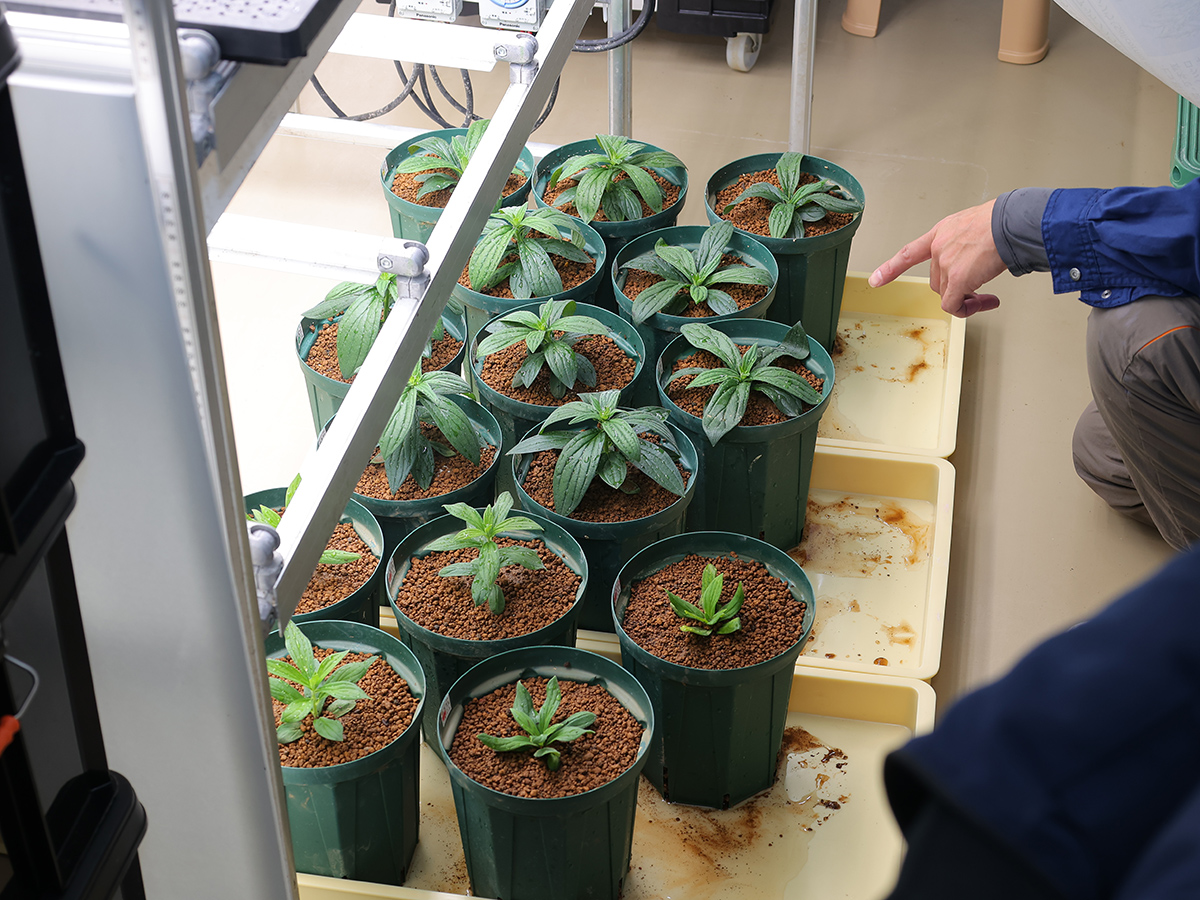
Seedlings of Lithospermum erythrorhizon in comparative study on the state of growth
More than 10 years of organic and natural farming experience to be a source of research
An organic field is located a short distance from the Conventional farming area (The Medium Field and The Large Field). About 20 kinds of vegetables are grown here without using chemical fertilizers or synthetic agricultural chemicals. This area is also used for the Agriscience Seminar, an open program for working adults, where participants can learn about organic farming while enjoying farm work.
▶︎ Details of the Agriscience Seminar, an open seminar for working adults (Japanese only)
“It is commonly thought that organic farming takes a lot of time and effort and produces only small quantities, but you can experience that this is not the case.” says TAKEDA Hajime, an Associate Professor, who also teaches open seminars for working adults. The yield is less than that of conventional cultivation, but surprisingly quite high.
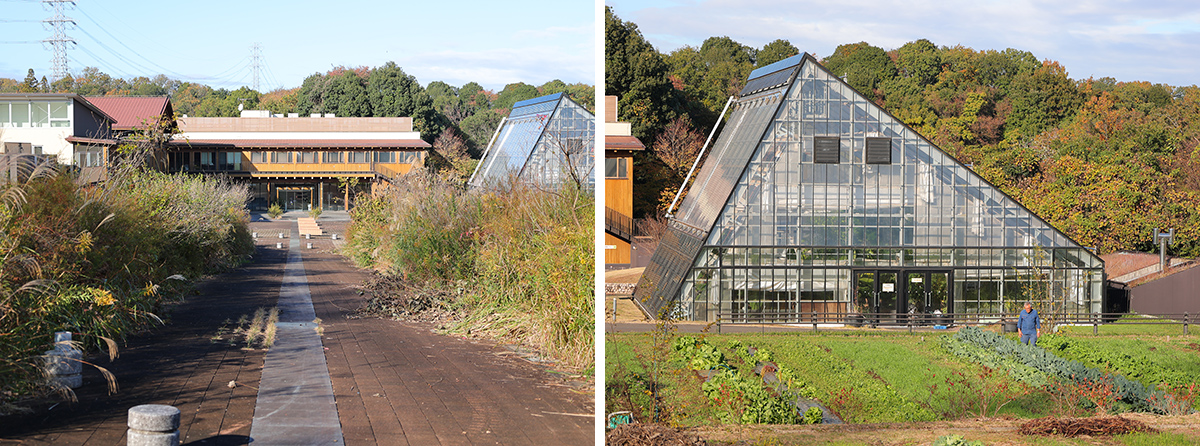
In addition, the cultivation experience in the ‛natural cultivation field’ course is also carried out. Without plowing the soil, or weeding, the field is left as it is, to be eaten by insects. However, damage by insects has been stopped at a certain degree. One reason for this is that leaving the field unattended also prevents natural predators from being eliminated. There are many earthworms and their droppings are resolved into soil, which becomes very soft, and delicious vegetables are produced.
Associate Professor TAKEDA says, “It is rare to find university farms that have been able to continue organic or natural farming for more than 10 years.” Because of the field’s long history, it is also full of “seeds” for research. He also asserted, “We are entering an era where organic farming cannot be ignored as a management option. This method can also be used for home garden.”
Research introduction vol. 4
Finding a way to prevent damage without pesticides and realizing sustainable agriculture
We are looking for ways to reduce spider mite damage on pears, which is common problem among our neighboring farmers. Spider mites are very small and difficult to find. Their population also explodes to 100 times the size in one to two weeks. In addition, pesticide resistance develops very quickly. Therefore, natural enemies are used instead of pesticides, but the timing of unleashing them is also difficult. If natural enemies are unleashed when there are no spider mites, they will starve to death, and if they are unleashed after spider mites have already increased too much, they will not catch up.
Therefore, we found the way to recognize the spider mite damage visually at an early stage by replacing part of the RBG value (color information) in the leaf image taken by a digital camera with the opposite color of the color ring. If this technology is applied to an app, it will be possible to take photos with a smartphone and check for spider mites.
In urban agriculture, it is important to devise ways to prevent damage caused by insects without large-scale capital investment. Chemical pesticides have achieved production volumes that can withstand population growth, but they also have considerable health and environmental impacts. In order to realize sustainable agriculture, we need to shift our focus to cultivating crops in a more natural environment, such as using natural enemies instead of chemical pesticides.
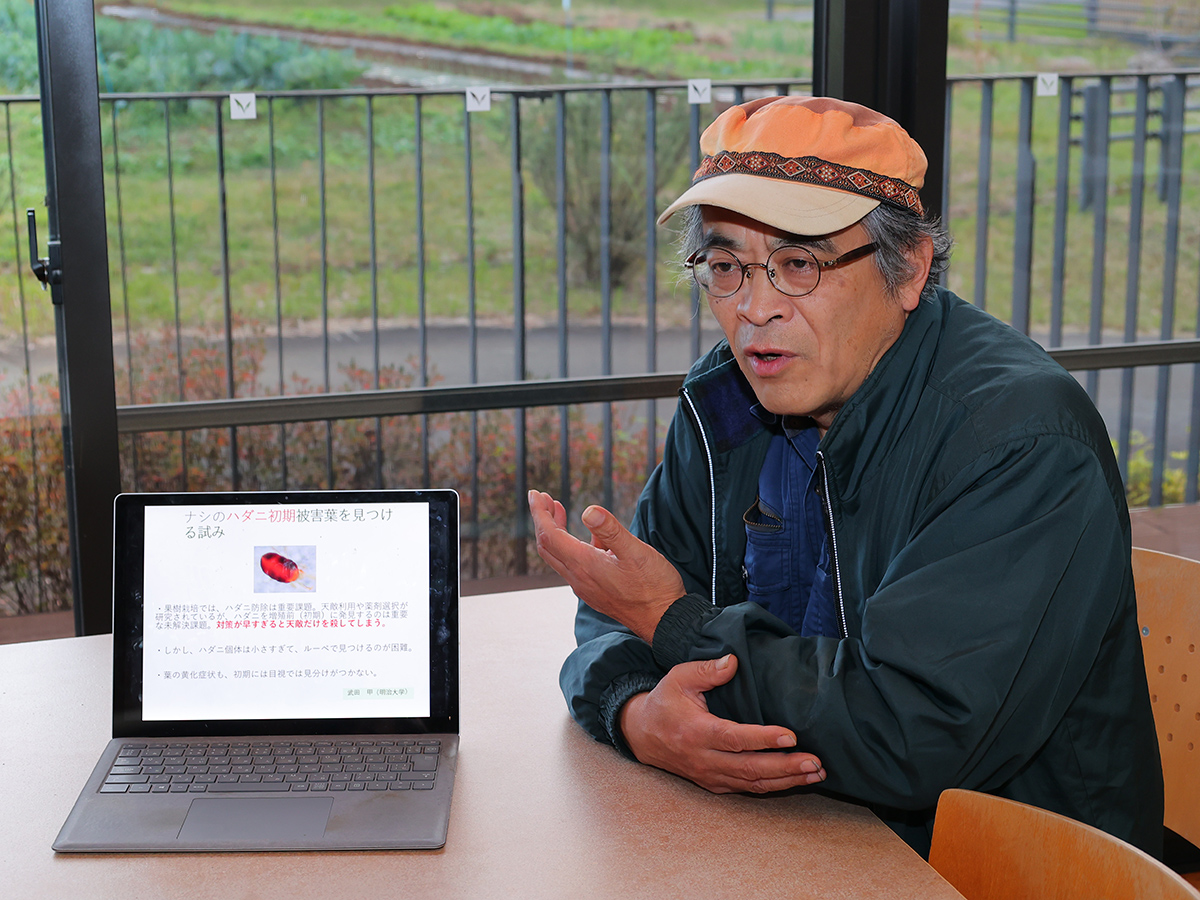
Associate Professor TAKEDA Hajime
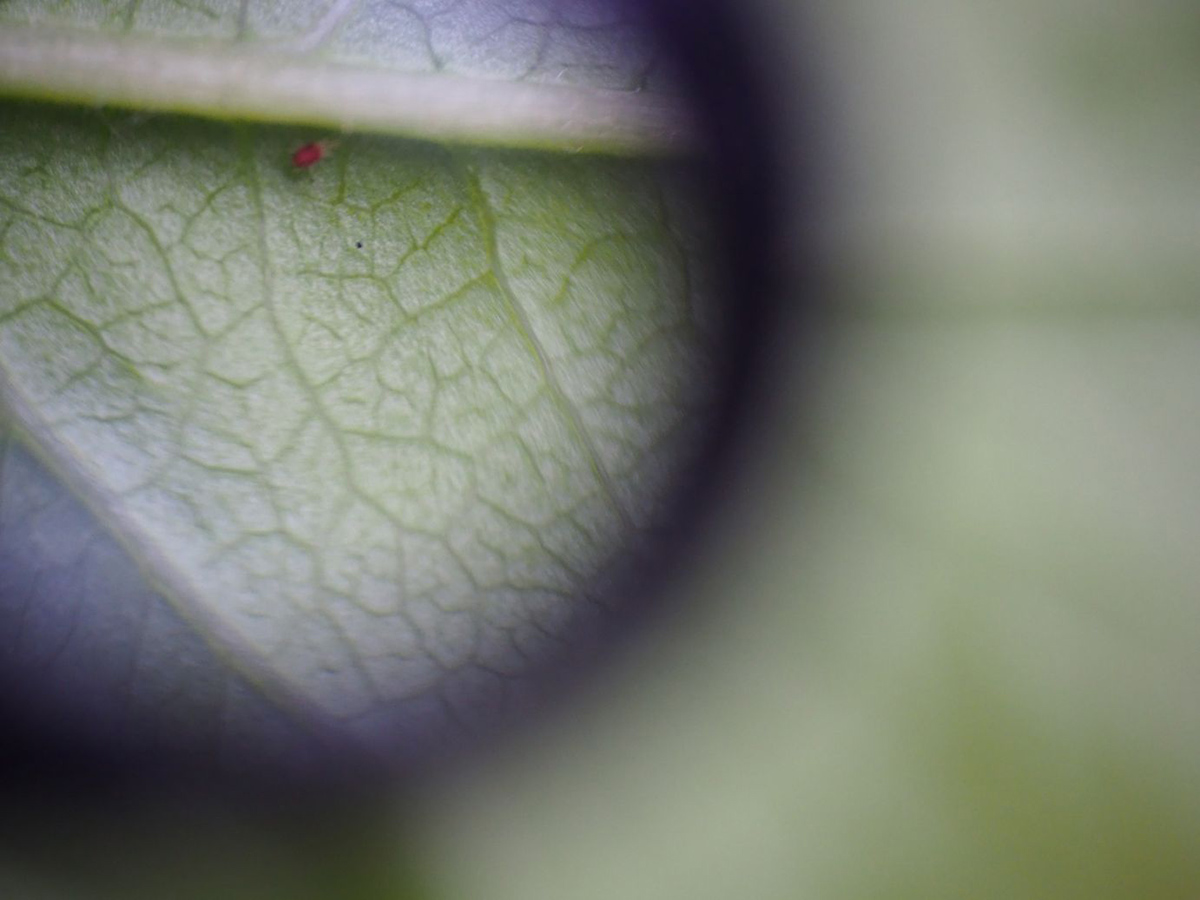
A spider mite on a pear leaf. Very small, about 0.4 mm to 0.6 mm
Addressing a variety of environmental, food, and resource depletion issues
Kurokawa Field Science Center has various other facilities and sites. In the exhibition greenhouse, subtropical fruit trees such as banana, papaya, pineapple and dragon fruit are cultivated. The academy building, built for lifelong learning, is a wooden building made only of domestic wood. Cedar from Kanagawa Prefecture is mainly used.
You can also observe the ecosystem of satoyama in the natural ecology garden centering around the biotope. On the other hand, students experience traditional satoyama management such as weeding the undergrowth and raking fallen leaves in the satoyama training at the School of Agriculture. They learn how nature is formed and how to cut down overgrown trees to rejuvenate thickets. Thanks to this kind of work done since it opened, the original vegetation seems to be recovering and rare plants can be seen.

As we face various environmental problems such as global warming, food problems, and the depletion of resources, the importance of the role of agriculture has come to be recognized once again. At Kurokawa Field Science Center, research focuses on highly efficient cultivation systems that can be developed in urban areas, and sustainable environmental conservation systems are mainly conducted. The center aims to contribute to the stable supply and effective use of food resources and the development of a natural environment suitable for the survival of all living organisms by deploying the results of these efforts on the actual production site.
* The information contained herein is current as of November 2024.
* The contents of articles on Meiji.net are based on the personal ideas and opinions of the author and do not indicate the official opinion of Meiji University.
Information noted in the articles and videos, such as positions and affiliations, are current at the time of production.

